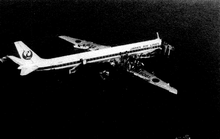
Seiji Katagiri
 Wreckage of JA8061
| |
| Occurrence | |
|---|---|
| Date | 9 February 1982 |
| Summary | Deliberate crash by pilot |
| Site |
Haneda Airport, Tokyo, Japan 35°32′14″N 139°46′57″E / 35.53729°N 139.78244°E / 35.53729; 139.78244Coordinates: 35°32′14″N 139°46′57″E / 35.53729°N 139.78244°E / 35.53729; 139.78244 |
| Aircraft | |
| Aircraft type | McDonnell Douglas DC-8-61 |
| Operator | Japan Air Lines |
| IATA flight No. | JL350 |
| ICAO flight No. | JAL350 |
| Call sign | JAPAN AIR 350 |
| Registration | JA8061 |
| Flight origin | Fukuoka Airport |
| Destination | Haneda Airport |
| Passengers | 166 |
| Crew | 8 |
| Fatalities | 24 |
| Survivors | 150 |
Japan Air Lines Flight 350 (日本航空350便, Nihonkōkū 350 Bin) was a McDonnell Douglas DC-8-61, registered JA8061, on a domestic scheduled passenger flight from Fukuoka, Fukuoka Prefecture, to Tokyo in Japan. The airplane crashed 9 February 1982 on approach to Haneda Airport in Tokyo Bay, resulting in 24 fatalities. Flight 350 was the first crash for Japan Air Lines in the 1980s. The investigation traced the cause of the crash to the deliberate actions of the captain.
Flight
The crew consisted of 35-year-old Captain Seiji Katagiri (片桐 清二 Katagiri Seiji), 33-year-old First Officer Yoshifumi Ishikawa, and 48-year-old flight engineer Yoshimi Ozaki. The cause of the crash was traced to Katagiri's deliberate crashing of the plane.
One report states that the captain engaged the inboard engines' thrust-reversers in flight. Another report states that, during descent, Katagiri "cancelled autopilot, pushed his controls forward and retarded the throttles to idle." Ishikawa and Ozaki worked to restrain Katagiri and regain control. Despite their efforts, the DC-8's descent could not be completely checked and it touched down in shallow water 510 meters (1673 feet) short of the runway. During the crash, the cockpit section of the DC-8 separated from the rest of the fuselage and continued to travel for several meters before coming to a halt.
Among the 166 passengers and 8 crew, 24 died. Following the incident, Katagiri, one of the first people to take a rescue boat, told rescuers that he was an office worker to avoid being identified as the captain. Katagiri was later found to have paranoid schizophrenia prior to the incident, which resulted in his being ruled not guilty by reason of insanity. Investigators for the Japanese government attributed the incident to a lack of proper medical examinations which allowed Katagiri to fly.
Katagiri has since been released from psychiatric care and lives near Mount Fuji.
See also
|
External links
- Final Accident Report – Aircraft Accident Investigation Commission (in Japanese)
Jan 13
Jan 23
Feb 21
Mar 11
Mar 20
Apr 26
Jun 8
Jun 21
Jun 24
Jun 28
Jul 6
Jul 9
Jul 23
Aug 11
Sep 13
Sep 29
Dec 9
Dec 24
| |
| International | |||
|---|---|---|---|
| Regional | |||
| Former | |||
| History |
|
||
| Services | |||
| People | |||
